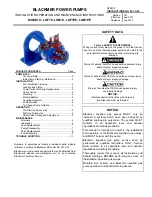
SE-04753
[Operation Manual]
24/49
DAIKIN INDUSTRIES, LTD.
[10. Test Run]
Supply hydraulic oil into the tank to the specified level, and conduct a test run after piping and electric wiring are
completed.
(Before turning ON the power supply, re-check if the ground cable and power supply cable are securely connected.)
Turn ON the switch on the machine control panel.
[1] Check the pump operation sound, and confirm that a pressure indicated on
the display panel increases.
[2] Confirm that the oil cooler AC fan motor is running.
NOTE) This hydraulic unit takes a warm-up time of approx. three seconds until it
starts operation after power-ON.
(The pressure rising time varies depending on the pipe volume.)
Furthermore, the hydraulic unit takes a time to increase the circuit pressure
above the set pressure of the pressure switch. During this period, the
pressure switch signal may be output depending on the pipe condition
(pipe volume). In such a case, set up the master machine so that it dose not
receive the alarm output.
After completion of the start check, set the circuit pressure at 1 to 1.5 MPa (low
pressure), and flush oil through the circuit for approx. two hours.
To conduct flushing operation, loop all pipes, and run the oil through a filter.
Before flushing operation, check all pipe connections for looseness and oil leak.
After completion of the flushing operation, check the filter for clogging. If the
filter is clogged, replace the filter, and drain all hydraulic oil from tank through
the oil drain port.
Fill new hydraulic oil through the oil filling port (air breather) to the specified
level.
(Use new clean hydraulic oil with pollution degree of NAS Class 9 or lower
level.)
Evacuate air from the hydraulic circuit completely. If air is not completely
evacuated, the following phenomena may occur.
[1] Abnormal operation of cylinder actuator
[2] Abnormal sound of pump and valve
DANGER
When evacuating air, high-pressure and high-temperature oil may spout out. Pay attention to oil splash.
Start check
Flushing
Oil replacement
Air vent
















































